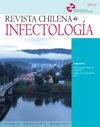儿科人群骨关节感染:过去15年的临床和微生物学
IF 0.2
4区 医学
Q4 INFECTIOUS DISEASES
引用次数: 0
摘要
本文章由计算机程序翻译,如有差异,请以英文原文为准。
Infecciones osteoarticulares en población pediátrica: clínica y microbiología de los últimos 15 años
Background: Timely diagnosis and treatment of pediatric osteoarticular infections (OAI) are imperative to avoid complications and sequelae, being relevant to know the local microbiology. Aim : To describe the characteristics of pediatric OAI treated in our center. Methods: Descriptive observational study. Patients under 15 years of age treated for OAI between 2004 and 2020 were analyzed. Clinical, laboratory, microbiology and treatment characteristics were evaluated . Results: 126 patients (63.5% men) were included, median age of 5.09 years (range: 0.5-14.6 years); 61.1% had septic arthritis (AS), 38.9% osteomyelitis (OM). Pain was present in 92.9% and fever in 68.3%. The most frequent location in AS was the knee (33.7%) and in OM the tibia (30.6%) and femur (30.6%). Agents were identified in 77 patients (61.1%), the most frequent being Staphylococcus aureus (n = 44), Kingella kingae (n = 13) and Streptococcus pyogenes (n = 8). The 4 patients with positive universal polymerase chain reaction (PCR) for K. kingae were not detected by other methods. Conclusion: The most frequent agent continues to be S. aureus , with an increase in its resistance, and this is the first report of K. kingae as a cause of OAI in Chile, specifically related to the use of molecular techniques.
求助全文
通过发布文献求助,成功后即可免费获取论文全文。
去求助
来源期刊

Revista Chilena De Infectologia
医学-传染病学
CiteScore
0.90
自引率
20.00%
发文量
53
审稿时长
4-8 weeks
期刊介绍:
La Revista Chilena de Infectología publica artículos en español sobre Infectología latinoamericana.
Los propósitos de nuestra revista son:
Difundir la experiencia nacional y latinoamericana en la especialidad
Divulgar la doctrina de la Sociedad Chilena de Infectología (SOCHINF) sobre el adecuado uso de los recursos diagnósticos, terapéuticos y preventivos de infecciones.
Las temáticas que cubre la revista son:
Antimicrobianos
Epidemiología de Infecciones
Infecciones de la Comunidad o Asociadas a la Atención de Salud
Infecciones en Hospederos Inmunocomprometidos
Microbiología
Parasitología
Patogénesis
VIH
Vacunas.
 求助内容:
求助内容: 应助结果提醒方式:
应助结果提醒方式:


